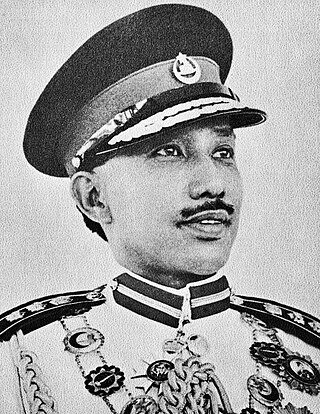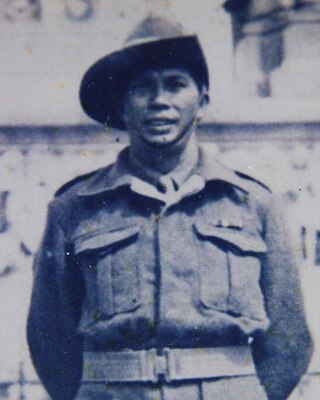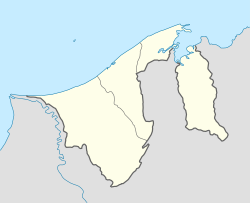
Omar Ali Saifuddien Sa'adul Khairi Waddien was the 28th Sultan of Brunei, reigning from 1950 until his abdication in 1967 to his oldest son, Hassanal Bolkiah.
Bolkiah ibni Sulaiman or commonly known as Nakhoda Ragam, was the sultan of Brunei from 1485 until his death in 1524, he ascended the throne upon the abdication of his father, Sultan Sulaiman. His reign was known as the "Golden Age of Brunei" due to its dominance throughout Borneo and the southern Philippines.
Muhammad Shah established the Sultanate of Brunei and was its first sultan, from 1368 to his death in 1402. The genealogy of Muhammad Shah remains unclear. He converted to Islam in the 14th century and assumed the name Sultan Muhammad Shah. Subsequent sovereigns of Brunei, governed by a Muslim administration, were referred to as sultans.

The Sultanate of Brunei or simply Brunei, also known as the Brunei Empire, was a Malay sultanate, centered around Brunei on the northern coast of Borneo in Southeast Asia. Brunei became a sovereign state around the 15th century, when it substantially expanded after the fall of Malacca to the Portuguese, extending throughout coastal areas of Borneo and the Philippines, before it declined in the 17th and 18th centuries. It became a British protectorate in the 19th century.
Muhyiddin ibni Abdul Jalilul Akbar was the 15th Sultan of Brunei and the fourth son of Sultan Abdul Jalilul Akbar. He took the throne after defeating his opponent, Sultan Abdul Hakkul Mubin during the Brunei Civil War. Notably, he also attempted to return the throne back to the origin bloodline via Sultan Muhammad Ali's family.

Brunei Museum, the country's largest and most significant national museum, is located in Kota Batu, Bandar Seri Begawan. This national museum houses a collection spanning Islamic art, Southeast Asian history from the 16th century, and extensive displays in archaeology and ethnography. Although the museum closed in 2014 for major repairs and upgrades, its much-anticipated reopening, initially set for 2020, has been delayed and remains closed as of 2022.
Abdul Jalilul Akbar ibnu Muhammad Hasan, posthumously known as Marhum Tua, was the sultan of Brunei. His verified reign of 61 years, make the longest of any Bruneian sovereign.

The Royal Brunei Mausoleum is a Royal Mausoleum of Brunei located at Jalan Tutong, Bandar Seri Begawan, Brunei. The Mausoleum is the main resting place and burial ground for several Sultans of Brunei and members of the Royal Family. The Royal Mausoleum was opened during the reign of Sultan Omar Ali Saifuddin I who later became the first monarch to be buried in the Mausoleum when he died in 1795.

Kampong Kupang or simply known as Kupang, is a village in Tutong District, Brunei, about 21 kilometres (13 mi) from the district town Pekan Tutong. The population was 1,795 in 2016. It is one of the villages within Mukim Keriam, a mukim subdivision in the district.

Kota Batu is a historical as well as populated area in Bandar Seri Begawan, the capital of Brunei. It is home to the Kota Batu archaeological site, a few of the country's museums and two mausoleums of the earliest Sultans of Brunei. However, the place is still populated and at present it is a neighbourhood of the capital.

Kampong Limau Manis is a village in the south-west of Brunei-Muara District, Brunei. The population was 1,097 in 2016. It is one of the villages within Mukim Pengkalan Batu, a mukim in the district. It is home to an important archaeological site in the country, dating back to the 10th century AD. Their primary economic activities were agriculture and collecting forest products.

The Ministry of Defence Brunei Darussalam, officially abbreviated as MinDef, is a cabinet-level ministry of the Government of Brunei. It is responsible for the national security and its military forces within the sultanate of Brunei Darussalam; the latter collectively known as the Royal Brunei Armed Forces (RBAF); Angkatan Bersenjata Diraja Brunei, (ABDB). MinDef is Brunei's ministry of defence; and was established on 1 January 1984, when Brunei Darussalam achieved independence from the United Kingdom. The Ministry of Defence leadership presently consists of a minister ; its incumbent is the Sultan of Brunei, Hassanal Bolkiah, who is also the Supreme Commander of the RBAF / ABDB. A deputy minister is second-in-command at the Ministry of Defence.

The Most Blessed Order of Setia Negara Brunei, also translated as The Most Blessed Order of Loyalty to the State of Brunei, is an order of Brunei Darussalam. It was established on 29 November 1959 by Sultan Omar Ali Saifuddien III.

Pengiran Anak Hajah Besar was a member of the royal family as the wife of Pengiran Anak Mohammad Alam and the mother of Pengiran Anak Saleha, the queen consort of Hassanal Bolkiah, the 29th Sultan of Brunei.

The Tutong people are an ethnic group native to Brunei, mainly in Tutong District. They traditionally speak the Tutong language. They are officially recognised as one of the seven ethnic groups of the Bruneian Malay race.

Cermin Island is an islet at the mouth of Brunei River in the Mukim Kota Batu, Brunei-Muara District, Brunei. During the Brunei Civil War, a battle unfolded on the island and it's sometimes referred to as the Peperangan Pulau Cermin. A proposal for an 5 hectares protection status to be implemented on the island. The island is home to sundry vegetation and swamp forests.

Pengiran Haji Mohammad bin Pengiran Abdul Rahman Piut, commonly referred to by his title Pengiran Temenggong and nicknamed National Hero, was a Bruneian nobleman, teacher and politician who formerly held several high-ranking positions which included being a member of the State Council, Privy Council, and the Islamic Religious Council. Notably, he is one of the founding members of the Royal Brunei Yacht Club and the Chairman of the Brunei Boxing Association.

Pengiran Muda Abdul Kahar was a nobleman and civil servant from Brunei who served as the chairman of the Tujuh Serangkai committee from 1953 to 1954, tasked with gathering the perspectives of Bruneian citizens, both rural and urban, on the proposed Constitution of Brunei, compiling a comprehensive report, and advising Sultan Omar Ali Saifuddien III during its drafting. Additionally, he was the appointed head of the Cheteria from 1951 to 1957.
The Kota Batu Archaeological Park is an archaeological park in Kampong Kota Batu, about 5 kilometres (3.1 mi) from Bandar Seri Begawan, Brunei. The Bruneian government's Museums Department is in charge of overseeing the Kota Batu archeological site and its surrounds, which comprise the mausoleums and the museum area, as they were gazetted under the Antiquities and Treasure Trove Act of 1967, and is regarded as a significant archeological site in Brunei.

Basir bin Taha was a Bruneian teacher who made significant contributions to education, welfare, and religion in Brunei. He played a pivotal role in raising awareness among Malay teachers about the importance of freeing the nation from colonialism and defending the sovereignty of both the monarchy and the people.
















